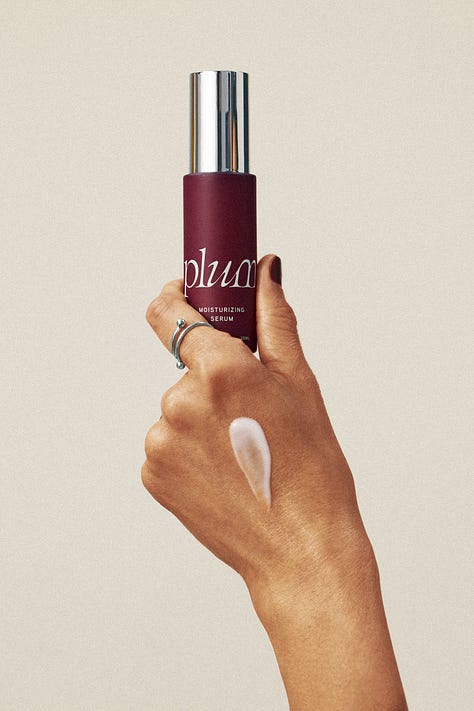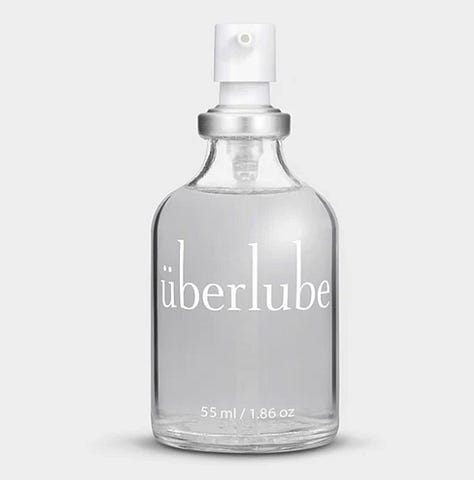The Vagina Dialogues
Breaking the silence on dryness: a must-read for those in search of comfort, pleasure and longevity.
“So you’re a vulva influencer now?”
My friend Graham has been a good sport over the years, enduring my relentless enthusiasm for the next big wellness trend: micro-dosed cannabis for sleep, microbiome-informed skincare, mushroom-powered mocktails, continuous glucose monitors — and now, hydration solutions for your “vaginal area.”
As an advisor, investor and former Chief Marketing Officer for early stage wellness brands, I definitely have a type. I’m drawn to rebellious, scientifically-backed brands that challenge outdated narratives with better-for-you products.
My latest focus? Elevating vaginal health as an integral part of overall wellbeing —enhancing comfort, boosting pleasure, reducing pain, and even promoting longevity.
It’s time to move conversations about women’s intimate health out of the shadows and into open, informed discussions with our doctors, practitioners, and yes, even our male partners.
In this post:
Female anatomy 101: Vagina vs vulva
All of the reasons for dryness: from pregnancy to perimenopause
Solutions: moisturizers, lubricants and vaginal estrogen
Health benefits: from pain relief to more orgasms
Send this to your best friend, sister, mother, grandmother, spouse, doctor, trainer, and even the men in your life. Let’s give women’s health the attention it deserves.
Vagina vs Vulva
For the longest time, the word “vagina” has been all encompassing to represent female genitalia when, it fact, it’s only part of our anatomy.
Here’s a quick overview:
Vulva
This refers to the external genitalia, which includes:
labia majora (outer folds)
labia minora (inner folds)
clitoris (highly sensitive organ of pleasure, including the external clitoral glans and hood as well as the internal network which extends beneath the surface forming a Y-shaped structure)
urethra (small opening for urine)
vaginal opening
Vagina
The internal muscular canal that connects the vulva to the cervix and uterus. The skin here is mucosal tissue (similar to the inside of your mouth) that naturally maintains a balanced pH and self-cleaning function.
Dealing with a Dry Spell
One of the most common symptoms women face throughout their lifetime is both external (vulva) and internal (vagina) dryness, which can lead to discomfort with daily activities, pain with intercourse and increased infections. The reasons for dryness are wide and varied but can be related to hormonal shifts, illness, exposure to products and use of medication:
Oral birth control
Pregnancy
Post-partum and breastfeeding
OTC medications like antihistamines or prescriptions like antidepressants
Dehydration or alcohol use (especially for lubrication)
Post laser hair removal or waxing
Medical treatments for cancer or other chronic illness
Perimenopause / Menopause
Genitourinary Syndrome of Menopause1 (GSM)
We have a skincare routine for the rest of our body so keeping our vulvar and vaginal tissues hydrated and healthy should be something we consider both preventatively and in response to symptoms, which can range from mild to severe.
"The vulvar and vaginal tissue responds to our environment, hormones, aging, medical issues (and their various treatments), product exposure and neglect just like all other tissue in the body! This means that a variety of solutions can meet our needs for comfort, sexual health and susceptibility to vaginal, vulvar and urinary tract inflammation and infections.”
— Dr Suzanne Gilberg Lenz, OBGYN and author of Menopause Bootcamp
For those of you in Los Angeles, Dr Suzanne will be launching her new concierge membership practice focused on holistic women’s healthcare and cutting-edge longevity in partnership with Monarch. Founding rates until March 31, 2025. Watch webinar [here] or apply [here].
Hydration Solutions 💦
Relief is available for both temporary and ongoing vaginal and vulvar dryness. An overview of the products and prescriptions that can support:
Vaginal Moisturizers
What is it: Internal hydrating products designed to be used regularly to maintain long term hydration and elasticity.
How to use: Applied every few days to help to restore and retain moisture in the vaginal walls. These suppositories or cream can be inserted into the vagina with fingers or an applicator.
When to use: Any time you experience dryness and want to maintain comfort. Especially beneficial for menopausal women experiencing discomfort and sensitivity due to declining estrogen.
Reasons to use: Internal moisturizers help prevent irritation, improve vaginal tissue integrity and enhance overall comfort.
Key ingredients: Often made with hyaluronic acid, aloe vera, and other hydrating agents suitable for sensitive skin. Hormone-free.
Vulvar Moisturizers
What it is: External hydrating products designed to maintain the moisture balance and protect the delicate skin of the vulva.
How to use: Applied externally to the labia and surrounding vulvar skin, these creams or serums are typically used daily, depending on individual needs.
When to use: Ideal for women experiencing external dryness, irritation, or sensitivity due to hormonal changes, harsh hygiene products, or skin conditions.
Why to use: Helps restore the skin barrier, reduce irritation, and provide long-lasting hydration to prevent discomfort.
Key Ingredients: Typically includes soothing and moisturizing ingredients such as hyaluronic acid, shea butter, vitamin E, peptides and ceramides. Hormone-free.
Suggested product: Plum Vagiceuticals Vaginal Moisturizing Serum2 an elegant, soothing topical with their proprietary VGP-80TM Peptide Complex for long lasting hydration.



Lubricants: Water-Based vs Silicon Based
What are they: Designed to reduce friction and discomfort during sexual activity. They offer temporary relief from dryness and irritation.
🚨 Women are 80% more likely to have an orgasm when using lube, according to Dr Emily Morse (podcast host of Sex with Emily and author of Smart Sex) so don’t wait for dryness to incorporate into sexual activity.
WATER-BASED LUBE
How to use: Applied directly to vaginal opening and/or on partner or sex toy before intimate activity.
When to use: During any sexual activity. Repeat applications may be necessary as these products absorb into tissue. Compatible with latex condoms.
Reasons to use: Provides natural-feeling hydration and washes off easily.
Key Ingredients: Typically includes water, glycerin and cellulose derivatives and sometimes a humectant like aloe or hyaluronic acid.
Suggested brand: Maude Shine Organic, aloe and water-based lube that is hypoallergenic and fragrance-free.
SILICON-BASED LUBE
How to use: A small amount is applied to the vaginal opening and/or on partner or sex toy before intimate activity.
When to use: Best for long-lasting lubrication, especially for those who experience severe dryness or discomfort, as silicon is not water-soluble so it remains slippery for longer. Compatible with latex condoms.
Reasons to use: A silkier texture and more durable glide which does not dry out, irritate sensitive tissues or alter vaginal pH.
Key Ingredients: Contains silicone-based ingredients such as dimethicone. It is hypoallergenic and preservative-free.
Suggested brand: Uberlube Signature Bottle, a non-sticky, paraban-free silicone lube with vitamin E.
Reading this substack is an investment in your health. Help me continue to create this content and grow this community—we are rebelling and redefining what it means to “be well.”
Vaginal Estrogen
What it is: A prescription, hormone-based treatment designed to restore vaginal tissue health by replenishing estrogen levels locally.
🚨 According to the NIH, approximately 50% of women experience some of the symptoms and physical changes of GSM but many do not seek treatment for this progressive condition. The estrogen deficiency can lead to vaginal dryness and burning, pain with intercourse, incontinence and increased infections.
How to use: It comes in various forms: creams, suppositories, and vaginal rings. Depending on the delivery method, it is dosed daily or applied a few times a week.
When to use: Safe for women in (peri)menopause (even cancer patients) who want to maintain tissue health, those experiencing tightness and itchiness, pain with sexual activity or recurrent urinary tract infections.
Reasons to use: Addresses the root cause of thinning vaginal tissue, decreased elasticity and blood flow by stimulating natural lubrication and thickening the vaginal lining. As an effective treatment for GSM.
Key Ingredients: Contains bioidentical or synthetic estrogen, such as estradiol or estriol, which acts locally without affecting systemic hormone levels.
Where to buy: Your local pharmacy with prescription from OBGYN, urologist or via telemedicine platform like Joi Women’s Wellness (CELIA15 for 15% off). Often insurance and HSA/FSA will cover the medication.
The takeaway: Women’s bodies are ever-changing and so are our needs. The dryness and discomfort that come with hormonal shifts throughout life’s seasons are normal yet manageable. We should think of our intimate health not as a luxury, but a longevity investment.
All writing is for informational and entertainment purposes only and is not a substitute for medical advice, diagnosis or treatment.
INVITATION | Thriving After Breast Cancer | June 5-10, 2025.
Join Dr Suzanne Gilberg-Lenz and Dr Corinne Menn, two of the country’s most notable OBGYNs for a luxury retreat filled with valuable education and activities to foster community for breast cancer survivors in Sintra, Portugal.
(Use code CELIA100 for $100 off your ticket)
I am on the Advisory Board for Plum Vagiceuticals. After vetting the team and product formulation, I am excited to be supporting their mission to educate women about vaginal/vulvar health.





